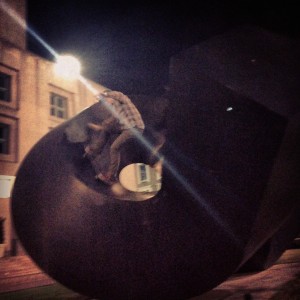 The image you see here was published a few months ago on the BWOG, Columbia’s student-run campus news site. Although the caption suggests that their editorial group appreciated the skateboarder’s midnight riding skills (“color us impressed”), in fact this kind of activity on a public outdoor sculpture is one of the worst things that can happen to the work of art itself. Sculptures in stone and metal naturally suffer from the elements of nature, from acid rain to guano, but they also suffer a great deal from the acts of humans. This ranges from the unconscious touching of sculptures, leaving oil residue that erodes the surface, or outright vandalism and abuse of the works of art themselves. Skateboarding on Clement Meadmore’s Curl clearly is an example of this latter abuse. This sculpture has been interpreted as many things, but the one thing that can be confirmed is that it is NOT a skateboard ramp!
The image you see here was published a few months ago on the BWOG, Columbia’s student-run campus news site. Although the caption suggests that their editorial group appreciated the skateboarder’s midnight riding skills (“color us impressed”), in fact this kind of activity on a public outdoor sculpture is one of the worst things that can happen to the work of art itself. Sculptures in stone and metal naturally suffer from the elements of nature, from acid rain to guano, but they also suffer a great deal from the acts of humans. This ranges from the unconscious touching of sculptures, leaving oil residue that erodes the surface, or outright vandalism and abuse of the works of art themselves. Skateboarding on Clement Meadmore’s Curl clearly is an example of this latter abuse. This sculpture has been interpreted as many things, but the one thing that can be confirmed is that it is NOT a skateboard ramp!
This abstract sculpture was the first commission for a public outdoor monumental sculpture that Clement Meadmore (1929-2005) received. Born in Australia, where he received his artistic training, Meadmore emigrated to the United States where he was influenced by Abstract Expressionism, Minimalism, and the improvisational sounds of jazz music. He began experimenting with Cor-Ten steel, and developed his signature fluid geometric sculptures that belie the industrial materiality of the metal with which they are made. Meadmore received this commission from businessman and philanthropist Percy Uris in 1967. The sculpture was installed at the Morningside Campus a year later as a gift from Uris to decorate the lawn of the new Business School building, which he had endowed. This sculpture made Meadmore’s international reputation, and he went on to receive numerous other commissions for public outdoor sculptures from universities, businesses, and cities around the world.
The natural degradation of the paint on the Cor-Ten steel has, unfortunately, made the Curl look less desirable today as it once did. However, a Task Force has been formed to address the concerns of this sculpture and to make recommendations for ways in which Meadmore’s first major work of art can be properly preserved and restored to its original glory. Stay tuned for more information about this.
And, as a reminder, please don’t ride skateboards on the sculpture!
Thank you: I came to this website specifically hoping that some sort of task force is making an effort to restore this beautiful sculpture; wonderful!
However I like this sculpture as much when ppl sit or lay down in its curve & enjoy the surroundings from within it. I wonder if there’s more *fine* a line between this & skateboarding than I would draw, and must express my opinion that ppl should be able to stand sit or lie in it.
I hope that protection of this lovely piece for the future does not end up meaning protection from people who seek a more tactile satisfaction (than just looking), within reasonable bounds.
Dear Anel: Thank you for your comment. Of course we can understand the desire and interest in wanting to physically engage with the sculptures on campus. Alma Mater seems to invite people to sit in her lap (which we have seen people do!). One could argue that physical interaction is the point of sculpture, and in a more controlled setting with protective materials that would be possible. However, nearly every conservationist would attest to the fact that human touch leaves residual oils and dirt, and these bodily products contribute to the degradation of the metal and stone of which these pieces are made. If you think about…touching sculpture in a museum is not permitted. This is to preserve the sculpture so that everyone can enjoy it. In many ways this is the same situation with public outdoor sculpture.